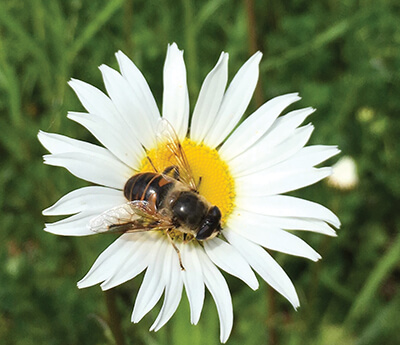
It’s spring and you survived the winter. As the sun re-emerges and the weather warms, honey bees begin taking their first real foraging trips to collect food for the colony. But of course, the flowers that are attractive to bees are also attractive to a broad range of other non-bee pollinators who are looking for food – from ants and wasps to beetles, butterflies, and flies.
Interactions at flowers between these bee and non-bee pollinators are oftentimes overlooked (they’re just getting food and don’t care about their fellow foragers, right?). However, new research indicates that bee-mimicking flies may play a role in spreading “bee” diseases – suggesting it may be worthwhile to look a bit closer at these interactions. This is the topic of our fifth “Notes from the Lab”, where we highlight “First detection of bee viruses in hoverfly (syrphid) pollinators”, written by Emily Bailes, Kaitlin Deutsch and colleagues and published in the journal Biology Letters [14:20180001 (2018)].
Why focus on hoverflies? Amazingly, we know very little about how “bee” viruses such as deformed wing virus (DWV) and sacbrood virus (SBV) impact non-bee insects, despite these viruses being detected in a broad range of distantly related taxa, such as wax moths, small hive beetles, earwigs, and even cockroaches! Are they actually “bee” viruses? Or are they viruses that infect lots of things but have mostly been observed in bees? Because flowers have been identified as a platform for disease transmission, interest has turned to insects that frequent the same flowers as bees.
Hoverflies are particularly abundant floral visitors that share flowers with bees. They’re widely regarded as the second-most important pollinators behind bees. And the larvae of many hoverfly species eat crop pests such as aphids, providing key biocontrol services that limit crop damage. So, hoverflies are doubly important in agricultural systems! Many hoverflies also look like bees (see photo), which helps protect them from becoming prey by fooling the would-be predator into thinking they have a stinger for defense (no hoverflies have stingers).
The visual similarities between hoverflies and bees have tricked many humans, too. I can’t tell you how many times in just the last year I saw an article about bee declines in the popular media and that picture of a “bee” was actually a hoverfly!
What did this new research find? Scientists from the University of Oxford, Royal Holloway, and Cornell collected 4 common hoverfly species from a meadow in Oxford, U.K., and screened them for common bee viruses. Two species of Eristalis hoverflies were found to be positive for sacbrood virus (SBV), black queen cell virus (BQCV), and varroa destructor virus-1 (VDV-1, a virulent strain of deformed wing virus).
Also, the strains of the viruses detected in hoverflies were the same as those found in co-foraging honey bees in the same meadow, indicating that these two distantly-related pollinators are likely sharing viruses freely. However, it is still uncertain whether the hoverflies are impacted by these viruses, as not enough flies were sampled.
Ok, so honey bee viruses were found in hoverflies – so what? Finding these viruses in hoverflies is really important. First, it identifies a previously unknown way for diseases to be moved around the environment, as hoverflies may act as vectors of the viruses and transmit them to susceptible bees. This is vital to understanding the ways in which bees are exposed to pathogens outside the hive environment.
But don’t grab your fly-swatter and begin smacking all the….


